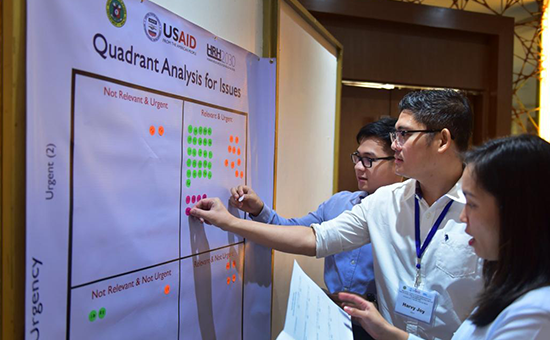
02 Oct The Future We Want: Increased Investments in National Health Workforce Accounts
This blog originally appeared on the Frontline Health Workers Coalition website.
When the World Health Organization released its Global strategy on human resources for health: Workforce 2030 four years ago, it included a series of milestones to be reached by 2020 including this one: All countries are making progress on sharing data on human resources for health through national health workforce accounts and submit core indicators to the WHO Secretariat annually.
Countries were challenged to focus on improving the availability and use of quality health workforce data through multi-sectoral engagement to respond to their population health needs. To date, at least 160 countries have contributed to the national health workforce accounts (NHWA).
During our years of implementing the USAID-funded Human Resources for Health in 2030 Program (HRH2030), we have seen that countries taking a multisectoral approach with an emphasis on stakeholder engagement and information systems strengthening are the ones who are making progress on sharing more and better health workforce data to inform strategic actions. Here are three examples:
Ethiopia’s information strategy, known as the Information Revolution, calls for advancing the use of quality data throughout the health system. Solomon Woldeamanuel Birru, responsible for HR planning, monitoring & evaluation in the Federal Ministry of Health’s Human Resources Development Directorate, has talked about the importance of an enabling environment for NWHA in Ethiopia. This has meant leveraging the Information Revolution to motivate multiple directorates of health within the FMOH that interact with the health workforce to participate in the sharing and use of data, as well as revitalizing the country’s human resource information system (HRIS). It has also meant involving stakeholders outside of health—such as ministries of science, higher education, and finance—that also contribute to health workforce development and management. This multi-sectoral approach has helped break down barriers normally seen in sharing and use of data. Driven by this collaborative effort, Ethiopia is now moving forward to operationalize NHWA, as well as rebuild the country’s HRIS, increasing the availability of quality data for decision making on health workforce investments, including the community health workforce, such as planning distribution and deployment based on population needs.
In Indonesia, the application of PEPFAR’s HRIS Assessment Framework (HAF) in late 2018, found that although the country’s human resource information system (HRIS) was strong, further investments were needed to enhance interoperability and strengthen the system capacity to improve data quality. The MOH’s Badan Pengembangan Dan Pemberdayaan SDM Kesehatan (BPPSDMK, the Board of Human Resources for Health Empowerment and Development) committed to this work, integrating NHWA into their regular operations, with a dual focus on strengthening the information system and engaging stakeholders to improve the availability and quality of data. NHWA was used strategically as a mechanism to prioritize these efforts both internally at the central level, and externally at the provincial and district levels. Today, not only is the country’s HRIS contributing to NHWA, the investments over the past few years primed the HRIS to provide timely, essential health worker information to support leaders during the COVID-19 response.
After the Philippines passed the Universal Health Care (UHC) Act in 2019, the Department of Health (DOH) adopted the NHWA as its roadmap for improving the availability and use of quality health workforce data, and to help respond to key policy questions to improve key health outcomes. NHWA implementation has been progressive, multisectoral, and built on existing systems. Uniquely among these three country examples, the Philippines has developed a strong governance structure for operationalizing the system, noting roles, responsibilities, and relationships, to go beyond the adoption of NHWA to ensuring its institutionalization. The main stakeholders include the DOH’s Steering Committee for HRH Initiatives, the multi-sectoral HRH Network, and leaders and managers from within the DOH’s Health Human Resources Development Bureau (HHRDB). The efforts for NHWA are helping to inform actions to carry out the newly developed HRH Master Plan for more equitable HRH distribution, managing HRH costs and funding sources, and local staffing and workload strategies to attain health for all.
As the United Nations wraps up its 75th General Assembly this year—under the theme “the future we want,” we’re thinking about the future we want. The collective vision that guided the creation of NHWA was the aspiration that all countries’ would take a multi-sectoral approach to both establish the priority policy agenda and progressively work to improve the availability, quality, and use of data on the health workforce, to help countries achieve their goals for human resources for health and support a high-performing health system.
During this global pandemic, we are realizing that now, more than ever, health workers are essential to drive health systems and improve health outcomes. It’s promising that targeted efforts like the NHWA can capture a progressively better understanding of our global health workforce for evidence-based actions. In the next decade, we hope to see information on community-based and social service workers integrated into this data. Now is an opportunity to hold countries accountable to take action with health workforce data that is more complete, timely, and high-quality to walk forward on the path to achieve the Workforce 2030 goals. The future we want—a future with a well-trained, well-equipped, well-supported health workforce—depends on it.
Rachel Deussom is the technical director on the HRH2030 Program at Chemonics. Leah McManus is the project lead on the HRH2030 Indonesia activity at Chemonics.
Photo: Stakeholders take a multi-sectoral approach to health workforce data in the Philippines. Credit: Alan Motus, Chemonics/HRH2030.





